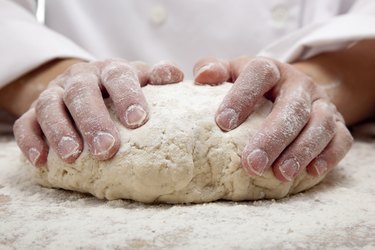
Get a rise out of your loaf of bread with proper kneading, which improves the structure of the loaf. Yeast bread recipes require kneading to build the structure of proteins that hold it together. Whether you choose to use a little elbow grease and knead the dough by hand, or let a machine do the heavy work, knowing what to look for in a finished dough can help prevent under- or over-kneading, which leaves you with an unfulfilling loaf of bread.
The Purpose of Kneading Dough
Video of the Day
The motion of kneading dough forms strong strands of gluten, which gives your bread a stronger structure -- whether you do it by hand or in a machine. In the process, the proteins in the dough organize themselves into a sturdy web with increased elasticity, which allows the dough to stretch as gas develops during the rising process. This ultimately maximizes the volume of your bread and enhances the texture of the finished loaf by giving it a fine grain.
Video of the Day
Kneading By Hand
Kneading dough by hand is an effective way to get familiar with how gluten develops, the way the dough looks during the different stages of kneading and how to judge whether or not the dough is kneaded enough. When kneading bread dough by hand, resist the urge to add more and more flour as you go. Although it helps reduce stickiness, it also changes the water-to-flour ratio and can alter the finished product. Instead, use a bench scraper to occasionally scrape dough that sticks to your work surface, if necessary.
Start by sprinkling a light coating of flour onto your work surface. Place your bread dough onto the surface, sprinkle a little more flour on top and then begin kneading. Push downward and outward, pressing the dough away from you with the heels of one or both of your hands. Fold the farthest edge over the top of the dough, rotate it 90 degrees and repeat the process until the dough is smooth and stretchy. Another method -- which usually works well for wet doughs such as ciabatta-- is to place the dough into a large, lightly oiled bowl and knead it against the oiled surface, which reduces the stickiness as you work the dough.
Kneading With a Machine
For faster kneading with less mess, attach a dough hook to your stand mixer, or use a food processor with a metal blade. If you're using a stand mixer, select a heavy-duty model as the motors in lighter mixers tend to burn out quickly. If you're using a food processor, keep in mind that the motor tends to generate heat as it kneads. To compensate, use cooler water -- around 70 degrees Fahrenheit -- to make the dough.
Start by adding the dough ingredients to the machine. Mix them on medium speed or pulse them together until the ingredients start holding together in a rough dough. Allow it to rest for approximately 10 minutes while the yeast and flour absorb the water. Continue kneading by mixing or processing the dough until it is smooth.
General Timing Information
In general, knead dough for 10 to 12 minutes by hand or approximately 8 to 10 minutes in a machine. As you knead bread dough, you'll notice that it goes through a few stages as the gluten develops into tight strands. The dough that begins as a lumpy mess progresses into a shaggy mass, and then ultimately into smooth, tacky ball of dough that holds its shape when you lift it in your hand.
If you're unsure if the dough is kneaded enough, give it the "windowpane test" by pulling off a piece of dough that's roughly the size of a golf ball. Stretch the dough into a sheet as thin as paper. If the dough breaks or tears quickly, continue kneading it; however, if it stretches without tearing, it's ready.
Over-Kneaded Dough Woes
When you knead dough by hand, your arms will become tired before the dough can become over-kneaded. However, if you're using a machine, stop every 2 to 3 minutes to check it. Bread made with over-kneaded dough ends up tough, with an unpleasantly hard crust and crumbly crumb. Although you can't undo it, letting the dough rise longer than normal can help relax the tight strands of overworked gluten. Over-kneaded dough feels tough and dense when kneaded against a work surface, it's difficult to flatten and fold on itself and it tears easily.